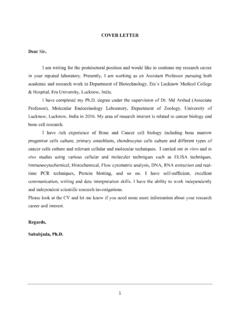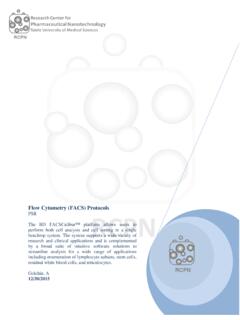Transcription of DNA Cell Cycle Analysis with PI
1 DNA Cell Cycle Analysis with PI. PROPIDIUM IODIDE: The most commonly used dye for DNA content/cell Cycle Analysis is PROPIDIUM IODIDE (PI). It can be used to stain whole cells or isolated nuclei. The PI intercalates into the major groove of double-stranded DNA producing a highly fluorescent signal when excited at 488 nm with a broad emission centered around 600 nm. Since PI can also bind to double-stranded RNA, it is necessary to treat the cells with RNase for optimal DNA resolution. The excitation of PI at 488 nm facilitates its use on the benchtop cytomters. Protocol for staining whole cells with PI: 1. Harvest cells and prepare single cell suspension in buffer ( PBS + 2% FBS; PBS +. BSA). 2. Wash and spin cells at 300 x g for 5 minutes X2 resuspend at 3-6 x 106 cells /ml.
2 3. Aliquot 500uL cells in a 15 ml polypropylene, V-bottomed tube and add 5 ml cold 70% ethanol dropwise while gently vortexing. If cells are not vortexed on addition to the ethanol, they will be fixed to each other in clumps. Fix cells for at least 1 hour at 4 C. ( cells may be stored in 70 % ethanol at -20 C for several weeks prior to PI staining and flow cytometric Analysis ). 5. Wash cells X2 in PBS as described above. (It may be necessary to centrifuge cells at a slightly higher "g" to pellet after ethanol fixation.). 6. Add 1 ml of propidium iodide staining solution to cell pellet and mix well. Add 50 ul of RNase A stock solution (final concentration ) and incubate overnight (or at least 4 hours) at 4 C. 7. Store samples at 4 C until analyzed by flow cytometry.
3 REAGENTS: Propidium Iodide Staining Solution: mM sodium citrate, 50 ug/ml PI [Sigma, P 4170] in PBS. RNase A stock solution: 10 ug/ml RNase A [Worthington Biochemicals, RASE LS005649, LS005650] (boiled for 5 min, aliquot and store frozen at -20 C). References: Crissman HA, Steinkamp JA. Rapid simultaneous measurement of DNA, protein and cell volume in single cells from large mammalian cell populations. J. Cell Biol., 59:766, 1973. Krishan A. Rapid flow cytofluorometric Analysis of cell Cycle by propidium iodide staining. J. Cell Biol., 66:188, 1975.









